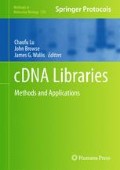Abstract
Transcriptome analysis by deep sequencing, more commonly known as RNA-seq is, becoming the method of choice for gene discovery and quantitative splicing detection. We published a double-random priming RNA-seq approach capable of generating strand-specific information [Li et al., Proc Natl Acad Sci USA 105:20179–20184, 2008]. Poly(A)+ RNA from a treated and an untreated sample were utilized to generate RNA-seq libraries that were sequenced on the Illumina GA1 analyzer. Statistical analysis of approximately ten million sequence reads generated from both control and treated cells suggests that this tag density is sufficient for quantitative analysis of gene expression. We were also able to detect a large fraction of reads corresponding to annotated alternative exons, with a subset of the reads matching known and detecting new splice junctions. In this chapter, we provide a detailed, bench-ready protocol for the double-random priming method and provide user-friendly templates for the curve-fitting model described in the paper to estimate the tag density needed for optimal detection of regulated gene expression and alternative splicing.
Access this chapter
Tax calculation will be finalised at checkout
Purchases are for personal use only
References
Li, H., Lovci, M. T., Kwon, Y. S., Rosenfeld, M. G., Fu, X. D., and Yeo, G. W. (2008) Determination of tag density required for digital transcriptome analysis: application to an androgen-sensitive prostate cancer model. Proc Natl Acad Sci USA. 105, 20179–20184.
Perocchi, F., Xu, Z., Clauder-Munster, S., and Steinmetz, L. M. (2007) Antisense artifacts in transcriptome microarray experiments are resolved by actinomycin D. Nucleic Acids Res. 35, e128.
Carninci, P., Kasukawa, T., Katayama, S., et al. (2005) The transcriptional landscape of the mammalian genome. Science 309, 1559–1563.
Cheng, J., Kapranov, P., Drenkow, J., Dike, S., Brubaker, S., Patel, S., Long, J., Stern, D., Tammana, H., Helt, G., Sementchenko, V., Piccolboni, A., Bekiranov, S., Bailey, D. K., Ganesh, M., Ghosh, S., Bell, I., Gerhard, D. S., and Gingeras, T. R. (2005) Transcriptional maps of 10 human chromosomes at 5-nucleotide resolution. Science 308, 1149–1154.
Karolchik, D., Baertsch, R., Diekhans, M., Furey, T. S., Hinrichs, A., Lu, Y. T., Roskin, K. M., Schwartz, M., Sugnet, C. W., Thomas, D. J., Weber, R. J., Haussler, D., and Kent, W. J. (2003) The UCSC genome browser database. Nucleic Acids Res. 31, 51–54.
Yeo, G. W., Van Nostrand, E. L., and Liang, T. Y. (2007) Discovery and analysis of evolutionarily conserved intronic splicing regulatory elements. PLoS Genet. 3, e85.
Hillier, L. W., Marth, G. T., Quinlan, A. R., et al. (2008) Whole-genome sequencing and variant discovery in C. elegans. Nat. Meth. 5, 183–188.
De Bona, F., Ossowski, S., Schneeberger, K., and Ratsch, G. (2008) Optimal spliced alignments of short sequence reads. Bioinformatics 24, i174–i180.
Langmead, B., Trapnell, C., Pop, M., and Salzberg, S. L. (2009) Ultrafast and memory-efficient alignment of short DNA sequences to the human genome. Genome Biol. 10, R25.
Weese, D., Emde, A. K., Rausch, T., Doring, A., and Reinert, K. (2009) RazerS–fast read mapping with sensitivity control. Genome Res. 19, 1646–1654.
Acknowledgments
The authors would like to thank the members of the Yeo and Fu laboratories for critical reading of this manuscript. This research was supported by grants to G.W.Y. and X.D.F. from the US National Institutes of Health (HG004659 and GM084317 and GM052872) for funding this research and the development of this protocol.
Author information
Authors and Affiliations
Corresponding author
Editor information
Editors and Affiliations
Rights and permissions
Copyright information
© 2011 Springer Science+Business Media, LLC
About this protocol
Cite this protocol
Lovci, M.T., Li, HR., Fu, XD., Yeo, G.W. (2011). RNA-Seq Analysis of Gene Expression and Alternative Splicing by Double-Random Priming Strategy. In: Lu, C., Browse, J., Wallis, J. (eds) cDNA Libraries. Methods in Molecular Biology, vol 729. Humana Press. https://doi.org/10.1007/978-1-61779-065-2_16
Download citation
DOI: https://doi.org/10.1007/978-1-61779-065-2_16
Published:
Publisher Name: Humana Press
Print ISBN: 978-1-61779-064-5
Online ISBN: 978-1-61779-065-2
eBook Packages: Springer Protocols

